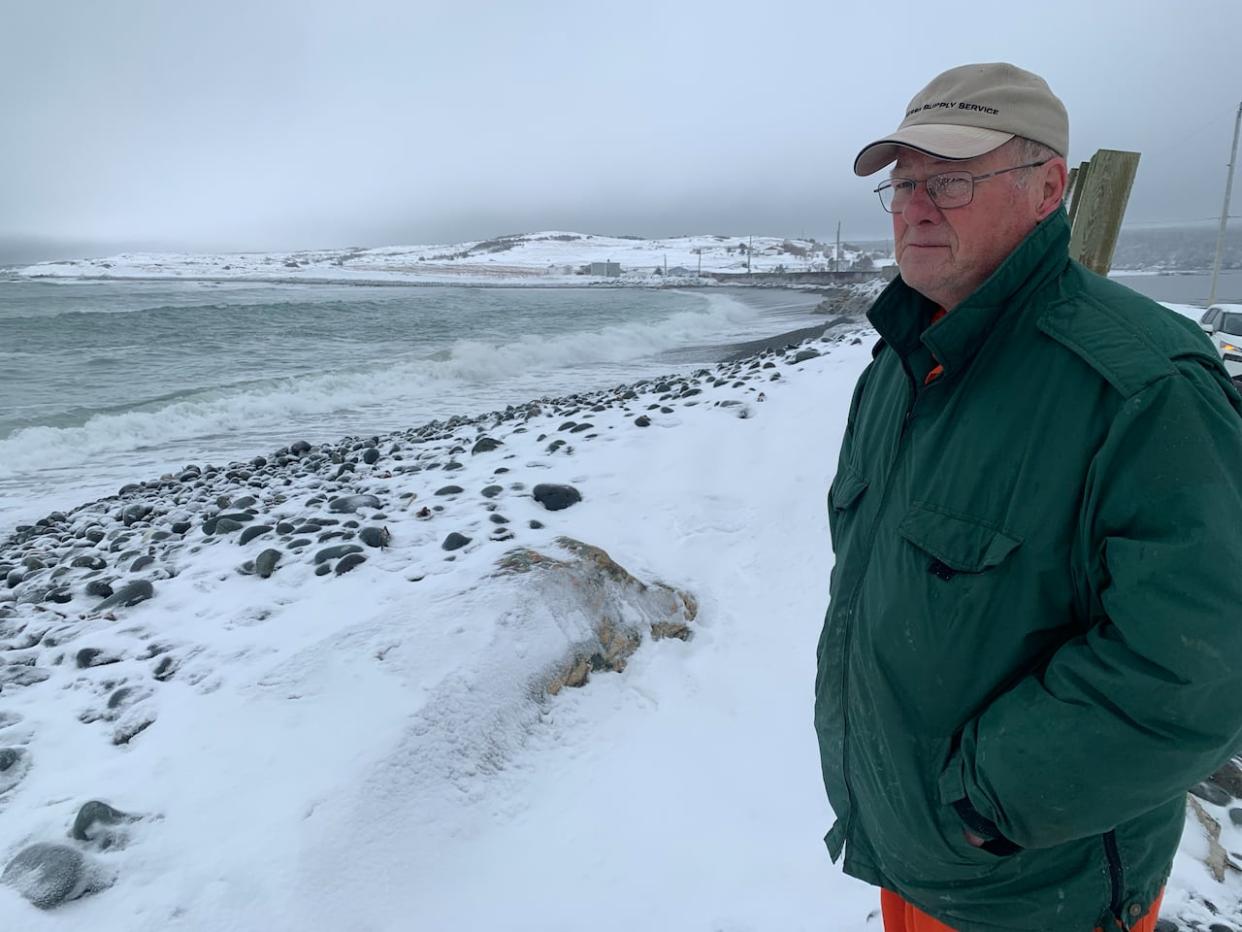Trepassey's breakwater was built last July with emergency funding. It lasted only a few months


Trepassey Coun. Collin Chaytor says that creating a breakwater strong enough to withstand the ocean's waves will be a costly challenge that the town's residents shouldn't have to bear. He is standing next to a temporary wooden wall where the breakwater stood. (Todd O'Brien/CBC)
After investing nearly a million dollars on a new breakwater last summer, the ocean has once again claimed the wall in the southern Newfoundland coastal community of Trepassey.
The new breakwater, constructed in July, lasted until last week when a storm reduced it to debris.
The storm also destroyed the nearby road, which the breakwater was built to protect.
Collin Chaytor, a town councillor, said the road connects residents there to a part of Trepassey known as "the lower coast," where at least 30 families live.
"We have so many families down here … the rest of the town has to be accessible," he said. "You're paying taxes like the rest of us, so you gotta be part of the town."
The breakwater cost $900,000, and was paid for largely by a federal emergency fund. The town's residents paid $120,000 toward the project's harmonized sales tax.
Chaytor says that maintaining a breakwater to protect the road against the raging sea is a constant struggle, especially given the frequent and increasingly harsh storms he has observed over the years.
The recent breakwater was not the first the town built, and he says it likely won't be the last.
"I don't know if this is solving the problem. As you can see, we're open to the ocean, [and] you can't fight Mother Nature."
He said the town is discussing a new breakwater with engineers. The question is money. He believes the funds for the breakwater construction and road repairs should not come from the town residents.
"This wasn't our problem. This was created by Mother Nature, and that's what an emergency is," said Chaytor.
The population of Trepassey — which depended on the fishery for generations — has declined over the years, with the 2021 census counting 405 residents, down from 570 a decade earlier.
"The economic base is not here anymore," he said.
"It's an aging population like a lot of rural communities. We try to do the best we can, and we can't afford to be throwing out [$30,000] or $40,000 here and there," he said.
A different town, similar problems
Aidan Costello, the mayor of Ferryland, a Southern Shore town north of Trepassey, says he remembers a ferocious storm two decades ago that destroyed the breakwater adjacent to the community's iconic lighthouse.
Afterwards, the town built a breakwater that they continue to fortify with new layers of stones to this day. However, washouts still occur and the area slowly erodes.
"Lighthouse Picnics have become quite an attraction over the last number of years," said Costello, referring to a company that operates from the Ferryland lighthouse during the tourist season.
"But the banks are being eroded, washed away. So pretty soon that area is not going to be safe for vehicle travel."
He said the town has been investing thousands of dollars in the breakwater, and it plans to spend more to strengthen it this summer.
"It seems like we're getting that 100-year storm every few years. So, I think we've got to build and prepare for those storms," he said.

Gerard Ryan, a resident of Trepassey for decades, has noticed how the climate and the power of the ocean have worsened over time. (Todd O'Brien/CBC)
Gerard Ryan, a resident of Trepassey for 63 years, has witnessed the town's changing landscape. He's seen the coastline erode, tides rise and winds strengthen over the years. The recent hurricanes and post-tropical storms, such as Larry, Earl and Fiona, have all howled at the town and its breakwater.
"The almighty sea saw our time working on this, putting it towards it and then took it away," he said. "Again, we're back to square one."
Ryan said the costs of rebuilding the wall and maintaining the road place a heavy burden on the residents of a small rural town, which has only a few construction companies and a grocery store.
"Once, we had a big fish plant [with] 700 people were working there. There was lots of business and lots of money," he said.
"It's not there anymore."
Download our free CBC News app to sign up for push alerts for CBC Newfoundland and Labrador. Click here to visit our landing page.


